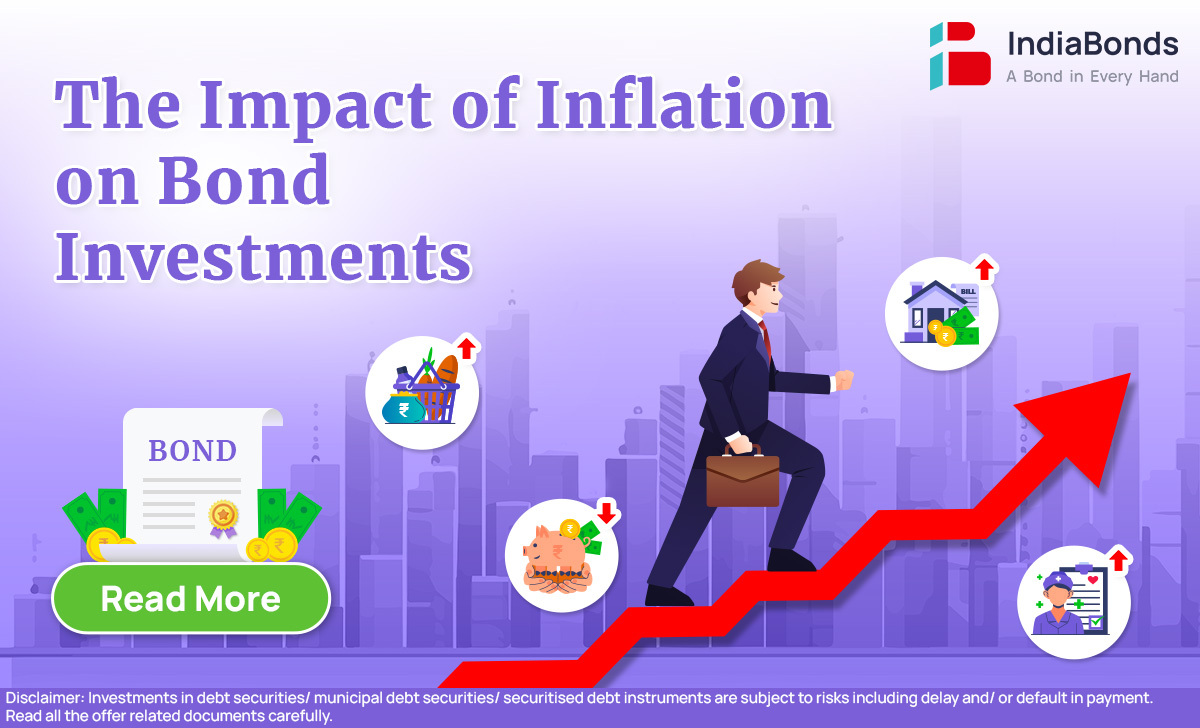The Impact of Inflation on Bond Investments

Introduction
Here’s a fun fact:
In 1970, a cup of coffee in India cost about 50 paise. Today, the same cup would cost you anywhere between ₹20 to ₹50, depending on where you buy it. That’s over a 4000% increase in price!
Now, I know there’s nothing fun about this fact, but what’s undeniable is the underlying culprit behind this is—inflation. It is arguably one of the arch-nemeses of financial investments and everyday life. We all feel it, we all see its effects. Inflation lurks around like a silent “wealth destroyer”, shrinking our purchasing power, day by day.
The Reserve Bank of India (RBI) steps in as the sentinel, tasked with taming this menace to ensure economic stability and sustainable growth. But inflation doesn’t just affect commodities and everyday prices—it impacts investor portfolios too. And yes, that includes bonds! So, what can investors like you and me do in this? Fret not—this article will take you through inflation, how it impacts bond investments, the role of the RBI and actionable strategies to safeguard your bond investments against inflationary risks.
What is Inflation?
Inflation at its core represents a general increase in the price level of goods and services over time. As prices rise, each unit of currency buys fewer goods and services, effectively reducing purchasing power. This persistent upward movement in prices means that the same ₹100 you have today will buy less in the future.
Main Drivers of Inflation:
Inflation primarily arises due to an imbalance between supply and demand. The key drivers include:
High Demand, Low Supply: When demand for products or services exceeds supply, prices tend to rise. This demand-pull inflation can be triggered by strong economic growth, increased consumer spending, or expansionary government policies.
Cost-Push Factors: Sometimes, inflation occurs because the cost of production (like raw materials, wages, or energy prices) rises, pushing manufacturers to pass on those costs to consumers in the form of higher prices.
Monetary Factors: When the central bank prints more money, or when there is an excess of liquidity in the economy, inflationary pressures rise.
To measure inflation in India, two key indices are used:
Consumer Price Index (CPI): This measures the average price change of a basket of consumer goods and services over time, reflecting the inflation felt by households.
Wholesale Price Index (WPI): This tracks the price change in goods at the wholesale level and often acts as a leading indicator of consumer inflation
Inflation can have wide-reaching effects on various asset classes, but one of its most noticeable impacts is on bond investments.
Impact of Inflation on Bond Investments
Bonds are fixed-income securities, and one of their defining features is that they pay a fixed interest, or “coupon,” over time. However, inflation can significantly erode the real value of these returns.
Let’s break this down with a simple illustration:
Imagine you invest in a bond with a 5% annual coupon rate, meaning you expect a 5% return each year. If inflation is running at 6%, your real return (i.e., the return adjusted for inflation) is actually -1%. Essentially, the purchasing power of your investment has declined, as the bond’s fixed interest is now insufficient to keep up with rising prices.
How Does This Happen?
Inflation impacts bond investments in two main ways:
Lower Real Returns: Since bond payments are fixed, higher inflation reduces the “real” value of these fixed returns. This is because the purchasing power of the interest payments you receive decreases as inflation rises.
Effect on Bond Prices and Yields: There’s an inverse relationship between bond prices and yields. When inflation rises, central banks typically raise interest rates to counteract inflationary pressures. Higher interest rates make existing bonds with lower coupons less attractive, causing their prices to fall.
For example, consider a bond paying a 4% coupon. If inflation spikes and the RBI raises interest rates to 6%, new bonds will offer higher yields. As a result, investors will favor these newer bonds, causing the price of your 4% bond to drop in the secondary market.
Thus, in an environment of rising inflation and interest rates, the prices of existing bonds fall, leading to potential losses if you sell before maturity. Conversely, in a falling inflation environment, bond prices rise as interest rates decline, allowing for capital appreciation.
Role of RBI in Managing Inflation
The Reserve Bank of India (RBI) plays a crucial role in controlling inflation and maintaining price stability. It has a dual mandate—keeping inflation in check while supporting economic growth. The primary tools at its disposal are monetary policy actions, which it uses to influence interest rates and money supply in the economy.
Here’s how the RBI manages inflation:
Repo Rate Adjustments: The repo rate is the interest rate at which the RBI lends to commercial banks. When inflation rises, the RBI increases the repo rate to make borrowing more expensive. This reduces consumer spending and investment, which helps cool down the economy and reduce inflationary pressures. Conversely, in a low-inflation environment, the RBI reduces the repo rate to spur borrowing and stimulate demand.
Open Market Operations (OMOs): Through OMOs, the RBI buys or sells government securities to regulate the liquidity in the banking system. Selling securities absorbs excess liquidity, helping to reduce inflation. Buying securities, on the other hand, injects liquidity to encourage growth.
Cash Reserve Ratio (CRR) and Statutory Liquidity Ratio (SLR): By adjusting these reserve requirements for banks, the RBI controls how much money banks can lend, thereby influencing the money supply in the economy.
Through these tools, the RBI aims to strike a balance between controlling inflation and supporting growth, which directly impacts the performance of bond investments.
So, What Can You Do?
With inflationary pressures eating into your bond returns, what can you as an investor do to protect your portfolio?
Here are some strategies:
Invest in Inflation-Indexed Bonds (IIBs): These bonds are specifically designed to shield investors from inflation. Their principal and interest payments are adjusted in line with inflation, ensuring that your returns keep pace with rising prices. IIBs can be a great hedge in inflationary environments.
Shorter-Duration Bonds in High-Inflation Periods: When inflation is rising, and central banks are expected to hike interest rates, short-duration bonds are more favorable. In one of our previous blogs, we understood the concept of duration—which essentially measures the change in a bond’s price with respect to changes in interest rates. For example, if a bond has a duration of 5, a 1% increase in interest rates would cause the bond’s price to decrease by 5%. This inverse relationship highlights how sensitive bonds are to rate changes based on their duration.
Hence, it’s but obvious that in periods of rising inflation, when central banks are expected to hike interest rates, selecting bonds with lower durations becomes a prudent strategy. Lower-duration bonds are less sensitive to interest rate changes, minimizing potential price drops. Additionally, they allow investors to reinvest in higher-yielding bonds sooner as interest rates increase, providing more flexibility in a rising rate environment.
Long-Duration Bonds When Inflation Falls: Similarly, on the other hand, when inflation is expected to decline, and central banks begin cutting rates, longer-duration bonds become attractive. As bond prices rise when interest rates fall, investors in long-duration bonds can benefit from capital appreciation.
Portfolio Diversification: Adhere to the golden rule of finance—diversify your portfolio. A well-diversified portfolio that includes a mix of equities, real estate and inflation-protected assets alongside bonds can help mitigate the risks posed by inflation.
Remember, while inflation erodes the real value of fixed returns, strategic adjustments to your bond holdings can help manage these risks.
Conclusion
Inflation is an inevitable reality, but it doesn’t have to be an insurmountable challenge for bond investors. By understanding how inflation impacts bond prices and yields, and by employing strategies like diversifying your portfolio and opting for inflation-indexed or shorter-duration bonds in the right circumstances, you can protect your investments. Ultimately, it’s essential to focus on inflation-adjusted returns rather than chasing high nominal returns. In a world of rising prices and shifting economic policies, informed investment choices will always be your best defense.
FAQs
Q. What is the relationship between inflation and bond yields?
A. Inflation typically drives up interest rates, which in turn lowers bond prices and increases bond yields. As inflation rises, new bonds with higher interest rates become more attractive, reducing the market price of older bonds with lower yields.
Q. How does inflation impact the purchasing power of bond interest payments?
A. Inflation erodes the purchasing power of the fixed interest payments from bonds. Even though the nominal coupon rate remains the same, the real return decreases as the cost of goods and services rises.
Q. How does RBI control inflation?
A. The Reserve Bank of India controls inflation primarily through adjustments in the repo rate, which affects the cost of borrowing. By raising rates, the RBI reduces demand and slows inflation. It also uses tools like open market operations and reserve ratios to manage money supply and liquidity in the economy.
Q. What can bond investors do to safeguard against inflation?
A. Bond investors can mitigate inflation risk by diversifying their portfolios, investing in inflation-indexed bonds, or opting for shorter-duration bonds in periods of rising inflation. Additionally, they should focus on inflation-adjusted returns rather than chasing high nominal yields.



















































